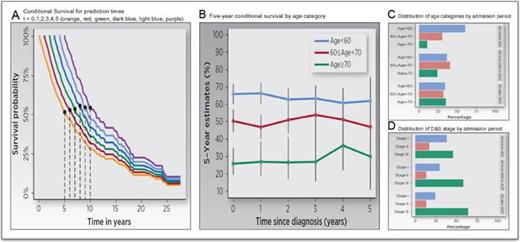Abstract
Introduction: Disease monitoring based on genetics or other molecular markers obtained by noninvasive or minimally invasive methods will potentially allow the early detection of treatment response or disease progression in cancer patients. Investigations in order to identify prognostic factors, e.g. patient's baseline characteristics or molecular markers, contributing to long-term survival potentially provide important information for patients with multiple myeloma. Overall survival (OS) is not very informative for patients who already survived one or more years. To better characterize long-term survival respectively long-term survivors, conditional survival (CS) analyses are useful. Conditional survival (CS) describes probabilities of surviving t additional years given they survived s years and provides information, how prognosis evolves over time. We have demonstrated the use of CS in a large data set of multiple myeloma patients with long-term survival which is mandatory for the calculation of CS (Hieke,... Engelhardt, Schumacher. CCR 2015).
Methods: We evaluated 816 consecutive multiple myeloma patients treated at our department from 1997 to 2011 with follow-up until the end of 2011. Patients' data were assessed via electronic medical record (EMR) retrieval within an innovative research data warehouse. Our platform, the University of Freiburg Translational Research Integrated Database Environment (U-RIDE), acquires and stores all patient data contained in the EMR at our hospital and provides immediate advanced text searching capacity. We assessed 21 variables including gender, age, stage and admission period. We calculated 5-years CS and stratified 5-years CS according to disease- and host-related risks. Component-wise likelihood-based boosting and variables selected by boosting were investigated in a multivariable Cox model.
Results: The OS probabilities at 5- and 10- years were 50% and 25%, respectively. The 5-year CS probabilities remained almost constant over the years a patient had already survived after initial diagnosis (~50%). According to baseline variables, conditional survival estimates showed no gender differences. The estimated 5-year survival probabilities varied substantially, from 25% for patients ages 70 or older to 65% for patients younger than 60 years. Similarly, patients with D&S stage I have an estimated 5-year survival probability of about 75% compared with 40% for patients with D&S stages II and III. Significant risk factors via Cox proportional hazard model were D&S stage II+III, age >70 years, hemoglobin <10g/dl, ß2-MG ≥5.5mg/dl, LDH ≥200U/l. Renal impairment, low albumin and unfavorable cytogenetics increased the risk, but failed to reach significance. Cytogenetics, response, response duration and other risk parameters post treatment are currently included in our assessment. Of note, over the study period, admission of patients <60 years decreased from 60% to 34%, but increased for those ≥70 years from 10% to 35%, respectively, illustrating that not only young and fit, but also elderly patients are increasingly treated within large referral and university centers and that patient cohorts and risks do not remain constant over time.
Conclusions: Conditional survival has attracted attention in recent years either in an absolute or relative form where the latter is based on a comparison with an age-adjusted normal population being highly relevant from a public health perspective. In its absolute form, conditional survival constitutes the quantity of major interest in a clinical context. We defined conditional survival by using the fact that the patient is alive at the prediction time s as the conditioning event. Alternatively, one could determine conditional survival, given that the patient is alive and progression-free or alive, but has progression at time s (Zamboni et al. JCO 2010). Analysis of the above and additional variables from diagnosis to prediction time s may refine conditional survival towards an even more specifically determined prognosis; follow-up response and risk parameters most likely further refining these CS analyses.
Wäsch:MSD: Research Funding; Janssen-Cilag: Research Funding; Comprehensiv Cancer Center Freiburg: Research Funding; German Cancer Aid: Research Funding.
Author notes
Asterisk with author names denotes non-ASH members.


This feature is available to Subscribers Only
Sign In or Create an Account Close Modal